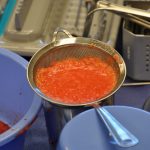Autogenous fat grafting continues to have tremendous appeal due to its ease of harvest, ample donor sites (in most patients) and injectability. But no matter how it is done, the fate of the injected graft can be unpredictable. Some may tout that retained volume of the graft is a reflection of the technique used, and while this is undoubtably true in some cases, technique alone is an insufficient explanation for all cases of suboptimal results.

One step in the fat grafting process is the initial harvest. Much has been looked at as to the effect of aspiration for acquisition. It certainly is a disruptive process and the negative pressures created by a vacuum system do cause significant cellular disruption. But what is the fate of the other non-fat cells which may be more significant to graft volume success?
In the October 2009 issue of the journal Plastic and Reconstructive Surgery, a study looked at some aspects of these issues. Comparing intact vs. liposuctioned fat samples, they assessed their anatomy and cellular make-up. To no surprise, fat acquired by sucking it out had many more broken up cells than that which was simply cut out up to 30% of lipoaspirated fat contained ruptured fat cells. (which are worthless from a re-injection standpoint) Unfortunately, straining or centrifuging liposuctioned fat will not necessarily get rid of much of this cellular debris. The study also showed that many of the cells that were in liposuctioned fat were blood cells rather than the more desireable fat cell-derived stromal or stem type cells.
This study confirms what all plastic surgeons know that liposuctioned fat has a lot of damaged cells and a poorer ratio of good progenitor cells than that which exists in fat that was simply cut out. This is one reason that injectable fat grafting remains such an unpredictable procedure, we are not putting in the best material possible. We are simply putting in the best material available that is easiest and relatively harmless to get. The process that makes it truly injectable (breaking it up into tiny little bits) is also what works against its survival after transplantation. In my Indianapolis plastic surgery practice, this is why I always tell patients we must initially overfill a fat injection site and hope for the best but the outcome is by no means assured.
Barry L. Eppley, M.D., D.M.D.
Indianapolis, Indiana


